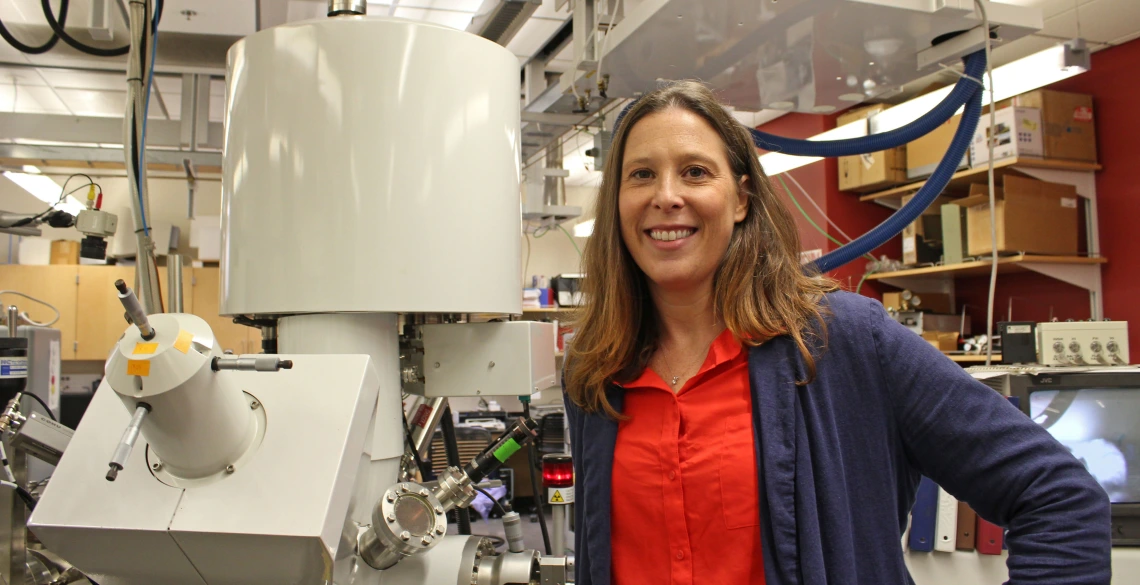Ratcliff Works to Scale Paper-Thin Solar Technology
Chemical and environmental engineering professor is one of two UA researchers to receive funding from the U.S. Department of Energy Solar Energy Technologies Office.

No description provided
Using a combination of multiple energy sources, including solar, makes the nation’s energy system more resilient. Solar energy provides about 3% of the country’s electricity overall and about 9% of Arizona’s, according to the U.S. Energy Information Administration.
The U.S. Department of Energy Solar Energy Technologies Office (SETO) selected University of Arizona chemical and environmental engineering associate professor Erin Ratcliff for a $300,000 grant to advance the near-term scalability of a specific type of solar cells known as perovskites.
Perovskite is a type of mineral, though the word is also used for lab-made materials that imitate the specific crystalline structure of the minerals. This structure gives perovskites properties like photoconductivity, and even allows them to be made into inks and printed onto ultra-thin, flexible pieces of plastic – similar to how newspapers are printed.
A solar panel so thin and portable it could be rolled up like a yoga mat presents a new world of options for what could be powered by the sun, ranging from avionics to wearables to technology needed in rural areas or disaster scenarios.
The perovskite industry is promising and fast-growing, with the tech moving from about 3% efficiency in 2009 to over 25% today. But, like many promising new technologies, perovskites still have some kinks to be worked out. Namely, they are not very stable, in part because temperature sensitivity causes them to degrade over time. The earliest perovskite devices worked for only a few minutes or hours, but today they have a lifespan of months. Ultimately, they’ll need to last for decades. Scientists and engineers are working to determine what keeps the cells from being stable.
“Perovskites are the highest-performing printable solar cell technology,” Ratcliff said. “But the operating hypothesis in the field is that defects are contributing to instability.”
With the SETO grant, Ratcliff and her team will develop a method for detecting these defects during manufacturing. The low-cost, scalable method will help scientists understand the way different parts and materials of the manufacturing process may contribute to defects and instability, and, in turn, how to mitigate these effects. The grant is part of SETO’s Small Innovative Projects in Solar 2022 Funding Program, which funds targeted, early-stage ideas in solar energy research that can produce significant results within the first year of performance. Nineteen projects received a total of $5 million in funding.
“What our project is about is trying to develop an in-line characterization tool to get you a quality control assessment to tell you how good the layers are in the exact moments you’re making them,” Ratcliff said. “This quality control method is also an indication for the long-term stability of the materials you’re making.”
Current techniques for detecting defects are used only after the material is produced. A technician might shine a light on the material and see how the material reacts, for example. Ratcliff is developing an electrochemical method. In addition to being able to detect defects during manufacturing, the method can also offer a more nuanced look at the potential presence of defects. It will involve using a robotic arm to apply a thin material, about the thickness of cellophane, to a solar panel being manufactured.
“You stick it on there and you apply an electric field on [the manufacturing] line, and you can figure out how it works under operation, without having to make the whole device first,” Ratcliff said.
Her defect quantification work is supported by the Office of Naval Research. She is also working with Tech Launch Arizona, the UArizona office that commercializes inventions stemming from university research.
“Large-scale manufacturing of these robust, high-quality perovskite-based photovoltaics will require low-cost and practical quality control methods that can be integrated into an operating line,” said Laura Silva, senior licensing manager for the College of Science at Tech Launch Arizona. “Ratcliff’s approach is overcoming these challenges and making the technology much more attractive in a marketplace that’s demanding higher and higher performance.”
Roger Angel, a UArizona professor of astronomy and optical sciences, also received $400,000 in funding through the SETO initiative to develop a method for changing the curvature of a mirror throughout the day to best capture the sun’s energy.

